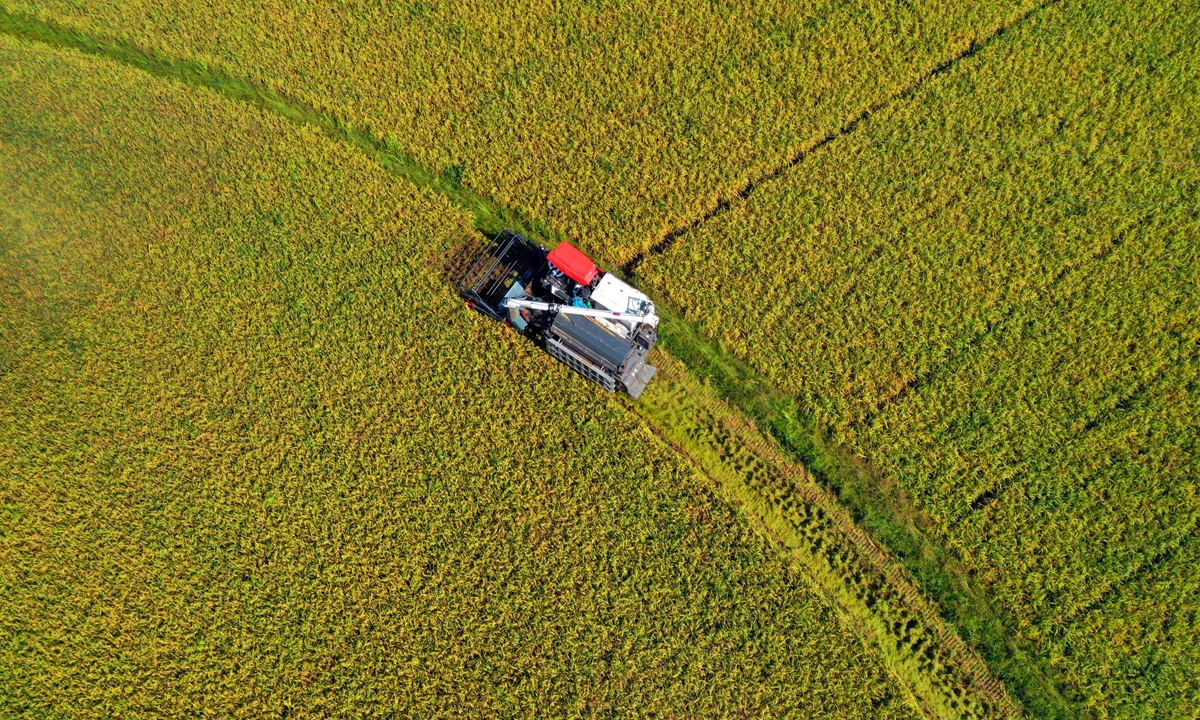China pulls off new record in grain output, expected to remain cornerstone of global food security

Farmers harvest early rice in Yongfeng, East China's Jiangxi Province on Tuesday. In the heat of the summer rush, farmers are busy harvesting 420,000 mu (28,000 hectares) of mature early rice to ensure that these summer grains are put into silos. China has set a grain harvest goal of 650 million metric tons and has achieved the target for six years in a row. Photo: VCG
The difficult feat attests to the country's targeted and effective response to a conflux of headwinds, as food security is adamantly high on the government's agenda, experts said.
China's capability to sufficiently feed nearly one-fifth of the world's population against all odds and at reasonable prices offers reassurance to a patchy global grain market, they noted, expecting the country to remain a cornerstone of global food security and economic stability.
New record
China's grain output in 2022 hit 686.53 billion kilograms, an increase of 0.5 percent from the year before, the National Bureau of Statistics (NBS) said on Monday.
The number pointed to a new record high and marked the eighth consecutive year that the country's total grain production has exceeded 650 billion kilograms.
The area of cultivated farmland stood at 1.775 billion mu (118.33 million hectares), up 0.6 percent from last year. Per unit output of grain reached 387 kg per mu, the NBS said.
The bumper harvest comes despite extreme regional weather conditions, including rare autumn flooding in the northern part of the country and extended drought and high temperature in the south, on top of COVID-induced disruptions, Wang Guirong, an NBS official, wrote in a statement dissecting the results.
In addition to extreme weather events that slammed part of the country with floods and some other parts with droughts, a spike in fertilizer prices amid the Ukraine tensions was seen weighing on the domestic grain market. Still, the nation pulled off a good result, Nie Fengying, deputy director of the Agricultural Information Institute of the Chinese Academy of Agricultural Sciences, told the Global Times on Monday.
Behind the record-making was a flurry of measures on multiple fronts to insulate grain production from its being inherently at the mercy of the weather, Jiao Shanwei, editor-in-chief of industry news website cngrain.com, told the Global Times on Monday.
He cited targeted moves at the central and local government levels to fight against droughts and floods such as the allocation of funds from government finances for drought and flood relief, the assignment of agricultural experts to on-site guidance that helped farmers with crop management in accordance with weather swings.
Pumping groundwater to irrigate drought-plagued crops was also among targeted and effective measures that come in handy as the government ratchets up its focus on food security, Jiao remarked.
Ensuring food production is a key component of wide-ranging efforts to strengthen food security, he emphasized, pointing to calls to fill Chinese people's rice bowls, mainly with Chinese grain.
Chinese leadership has described food security as among the country's most fundamental interests, and has on multiple occasions stressed farmland protection and improvement, development of seed industry, collection and protection of germplasm resources, as well as supporting farmers and agriculture in all ways possible.
As a net importer of farm produce, China's imports of agricultural products gained 9.4 percent year-on-year to $20.62 billion in November while its exports were up 4.6 percent to $8.83 billion, according to Chinese customs statistics.
China's food imports mostly comprise imported soybeans that account for over 70 percent of the total imports, while its net grain imports merely made up roughly 3 percent of total grain output over the past five years, He Xiurong, professor of College of Economics and Management, China Agricultural University, wrote in an article published last summer.
Recalling a national food security strategy proposed by the annual Central Rural Work Conference in December 2013 that called for ensuring basic self-sufficiency in grain, He stressed that as a responsible major power, China's unwavering push for food security over the years meets its own needs as well as makes a huge contribution to steadying global food supplies and demands and food prices.
Cornerstone of global food security
While the repercussions of geopolitical tensions might remain a drag on global food security next year, China's adeptness at responding to emergencies and its responsible approach to feeding its gigantic population would render the country a sustained cornerstone of global food security, observers said.
The 2022 harvest has laid a solid foundation for China to cope with a complex and volatile international environment, overcome risks and challenges, and stabilize economic growth and ensure the economy expands within a reasonable range, NBS' Wang said.
The harvest also made positive contribution to stabilizing the global grain market and ensuring food security, the official continued.
Looking ahead, the prolonged fallout from the Ukraine crisis may add to the upward pressure on oil prices and cast uncertainty on seaborne transport, Nie said.
As agricultural production is de facto linked to oil that's for instance used in the manufacture of agricultural plastic films, food security at large might still be subject to uncertainties, she believes.
In a note in late September, the IMF said the Ukraine crisis "has exacerbated food insecurity that had already been on the rise for half a decade."
Low-income countries are taking the heaviest hit, according to the IMF, reckoning that "the food and fertilizer price shock would add $9 billion in 2022 and 2023 to the import bills of the 48 most affected countries."
In the words of Jiao, so long as China readies itself for potential extreme conditions, as it has done throughout the year, the country will surely find its groove when it comes to achieving grain security in the face of geopolitical and economic perplexities.
With increased grain output, China was also considered to have done its part in allaying woes over rising food prices amid the Ukraine crisis.
China's consumer price inflation rose by 2.3 percent year-on-year in November, NBS data showed. In the first 11 months of the year, the CPI recorded an average rise of merely 0.9 percent from the prior year.
The country's mild inflation, in stark contrast to record-high inflation levels in Europe and the US, arguably makes the Chinese economy one of the most responsible for global economic health, analysts said.
While China is anticipated to continue its role as a pivotal stabilizer to global food security, experts also shone attention on a joint push to fix the patchy grain market across the globe.
Some African and Latin American countries, among those lacking agricultural resources, might face worse prospects as geopolitical tensions will continue into 2023, crippling supply chains and haunting their grain trade, Jiao said.
As a consequence, inadequate food supplies due to supply chain issues and a continued hot food inflation would subject these countries to a more worrying hunger problem next year, he said, calling for global efforts to jointly tackle the problem.




